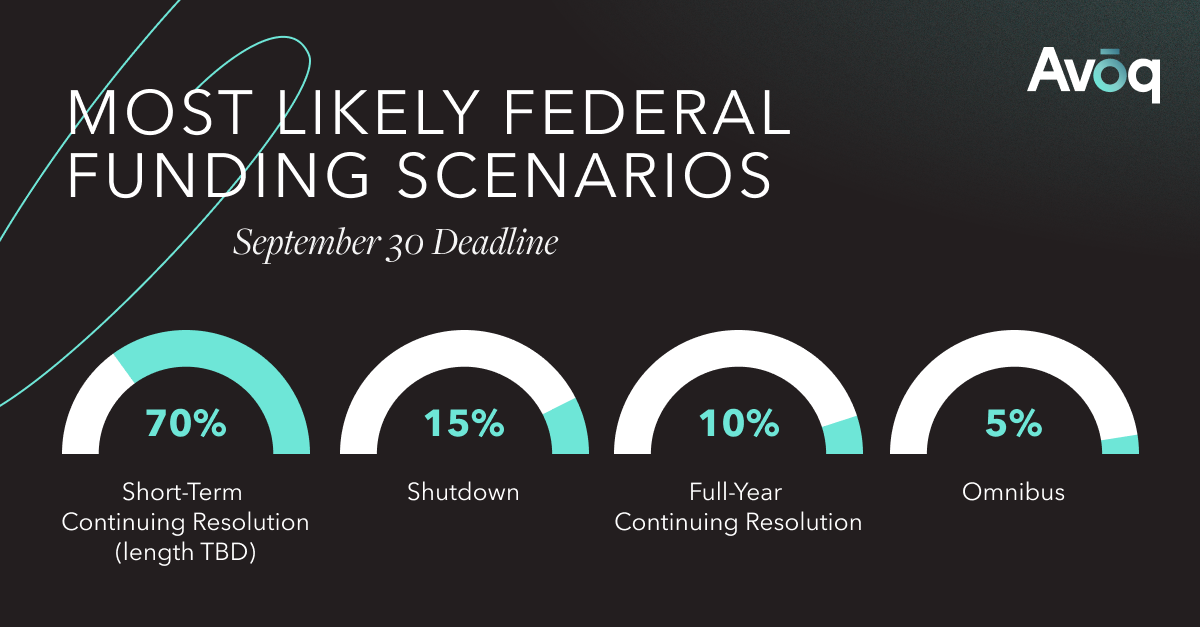As the September 30 FY2026 deadline approaches, Congress faces mounting pressure to avert a government shutdown amid a slow-moving appropriations process and heightened policy tensions.
Current Bottom Line:
A short-term Continuing Resolution (CR) is the most likely outcome to avoid a shutdown by September 30th. However, shutdown risk remains elevated due to unresolved political and policy fights. If a CR extends well into the winter without resolution, a full-year CR becomes increasingly plausible. Below is an overview of the most likely funding scenarios, their rationale and operational implications.
The key factors driving these dynamics include:
- Limited time and legislative progress on FY2026 appropriations
- Bipartisan agreement is still needed, especially in the Senate
- Increased policy disputes across health, safety and fiscal priorities
- Momentum and public signals point toward a CR as the most viable near-term path
Funding Scenario #1:
Short-Term CR into Nov/Dec or Q1 2026
70% Likelihood
Appropriations progress remains insufficient for full-year funding through regular order. While the House has passed some bills, the Senate has moved fewer and a topline agreement remains elusive. Bipartisan talks are underway on a short-term “clean” CR to provide more time for negotiations and avoid a shutdown. The White House is signaling support for a CR possibly extending into early 2026.
Operational Implications:
- Agencies operate at current funding levels
- No new program starts (absent specific anomalies)
- Slower award cycles; formula grants continue
Funding Scenario #2:
Partial or Full Government Shutdown Starting Oct. 1
15% Likelihood
Disagreements over spending levels and contentious policy riders (e.g., ACA provisions, crime policies, rescissions) could block bipartisan agreement on a CR. The political environment, including election-year dynamics and procedural tensions (e.g., Senate nominations), may further complicate passage.
Operational Implications:
- Excepted services (e.g., national security, air traffic control) continue
- Many administrative functions, parks, and permitting processes pause
- Contracting and grant cycles delayed; furloughs/unpaid work likely in affected agencies
Funding Scenario #3:
Full-Year CR for FY2026
10% Likelihood
Following FY2025 precedent, a year-long CR could emerge if a stopgap CR continues into the winter without a topline deal. While not the preferred outcome, it may become a fallback if negotiations stall further.
Operational Implications:
- Flat funding for the full fiscal year
- No program changes; limited flexibility
- Planning and new initiative timelines are delayed
Funding Scenario #4:
Minibus/Omnibus Enacted by Sept. 30
5% Likelihood
Following FY2025 precedent, a year-long CR could emerge if a stopgap CR continues into the winter without a topline deal. While not the preferred outcome, it may become a fallback if negotiations stall further.
Operational Implications:
- Flat funding for the full fiscal year
- No program changes; limited flexibility
- Planning and new initiative timelines are delayed




